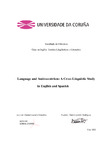Language and Androcentrism: A Cross-Linguistic Study in English and Spanish

Use este enlace para citar
http://hdl.handle.net/2183/34363Coleccións
Metadatos
Mostrar o rexistro completo do ítemTítulo
Language and Androcentrism: A Cross-Linguistic Study in English and SpanishAutor(es)
Director(es)
Lezcano, EmmaData
2022Centro/Dpto/Entidade
Universidade da Coruña. Facultade de FiloloxíaDescrición
Traballo fin de grao (UDC.FIL). Inglés: estudios lingüísticos y literarios. Curso 2021/2022Resumo
[Abstract] Patriarchy is a social order that has pervaded all aspects of our socialization, including
language. Aiming at preserving the male-dominated status quo, languages have been constructed
from an androcentric viewpoint which reinforces women’s subalternity in the non-linguistic realm.
This paper thus endeavors to shed light on women’s linguistic situation and the societal impact of
linguistic sexism. To attain this, in the first place, I examine the question of language and
androcentrism. As can be seen, languages undergo a male-biased process of acculturation which
results in them absorbing, shaping into and reflecting the patriarchal social order. In the second place,
I draw upon Deutscher’s (2011) theory on linguistic relativism, which purports that linguistic patterns
can eventually become mind habits—i.e. language influences memory, perception, associations, etc.
Therefore, in being androcentrically constructed, language makes the perfect means to reinforce our
binary interpretation of the world. Thirdly, I delve into what I consider to be the three possible main
pillars of linguistic sexism. This part thus explores (1) the dictionary as a male-biased object that
shapes usage and discourse, (2) sexist expressions in English and Spanish and their power to render
the masculine normal and the feminine abnormal, and (3) the generic masculine and the tendency to
dissolve the feminine into the masculine, which demonstrates that the hierarchical relationship “Man
v. Woman” that exists culturally is echoed grammatically. Moreover, due to its current popularity
with the youth, special attention is given to the singular use of they. Lastly, I put forth a
cross-linguistic analysis of nursery rhymes and canciones infantiles to add a fourth pillar to what I
have considered to be, along with the other three, the stronghold of linguistic sexism. To carry out
this analysis, the songs have been grouped thematically into “Gender violence”, “The Domestic
Realm”, “Objectification”, and “Gender Identity”. In so doing, I aim to illustrate how the binarism
“Men v. Women” and androcentrism are instilled in children by means of language. As a result, the
literature review and the cross-linguistic analysis carried out in this paper evidence that the male elites
have historically strived to turn language into a male-dominated instrument, thereby weaponizing its
influence over our cognitive processes to perpetuate women’s subjugation to men. Ultimately, my intention is for this paper to raise awareness of a subtle, underestimated type of sexism which grows
stronger the less people know about it.
Palabras chave
Androcentrism
Patriarchy
Linguistic sexism
Linguistic relativism
Feminism
Patriarchy
Linguistic sexism
Linguistic relativism
Feminism
Dereitos
Os titulares dos dereitos de propiedade intelectual autorizan a visualización do contido deste traballo a través de Internet, así como a súa reproducción, gravación en soporte informático ou impresión para o seu uso privado e/ou con fins de estudo e de investigación. En nengún caso se permite o uso lucrativo deste documento. Estos dereitos afectan tanto ó resumo do traballo como o seu contido Los titulares de los derechos de propiedad intelectual autorizan la visualización del contenido de este trabajo a través de Internet, así como su repoducción, grabación en soporte informático o impresión para su uso privado o con fines de investigación. En ningún caso se permite el uso lucrativo de este documento. Estos derechos afectan tanto al resumen del trabajo como a su contenido





